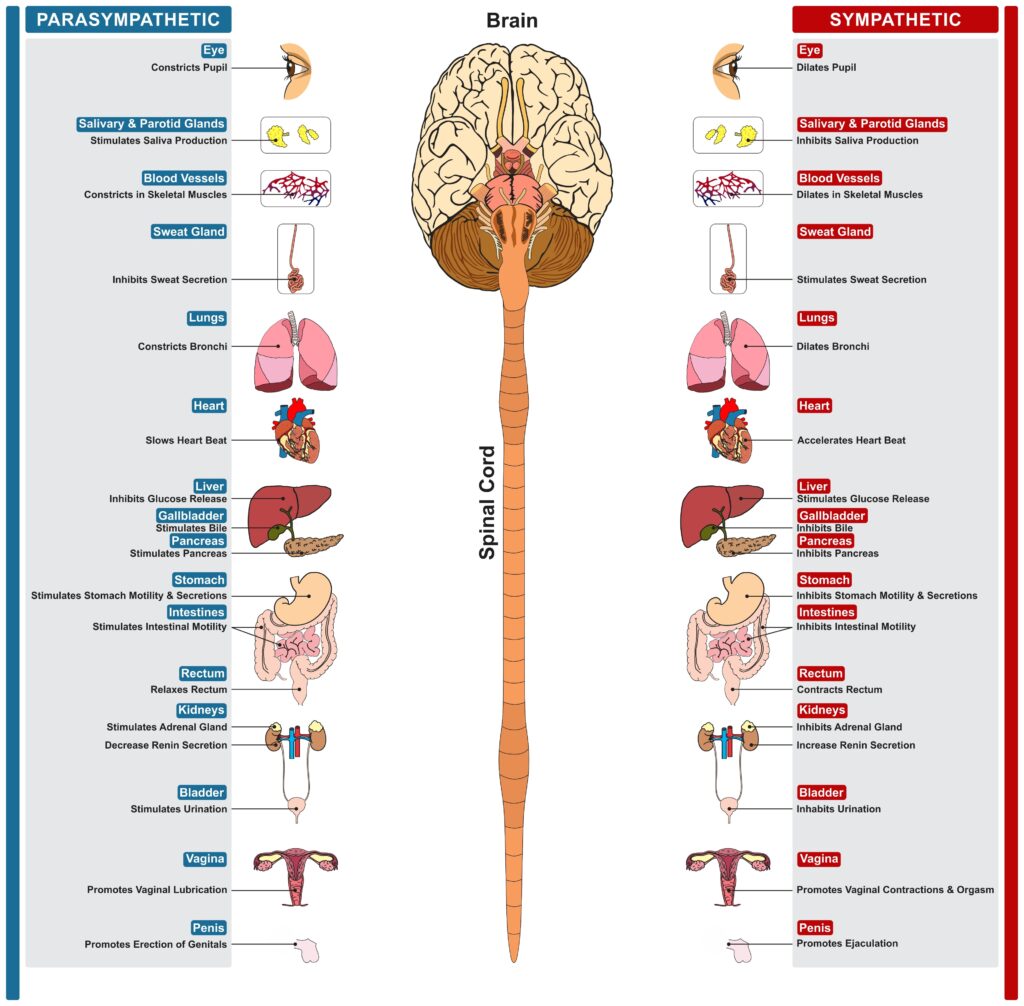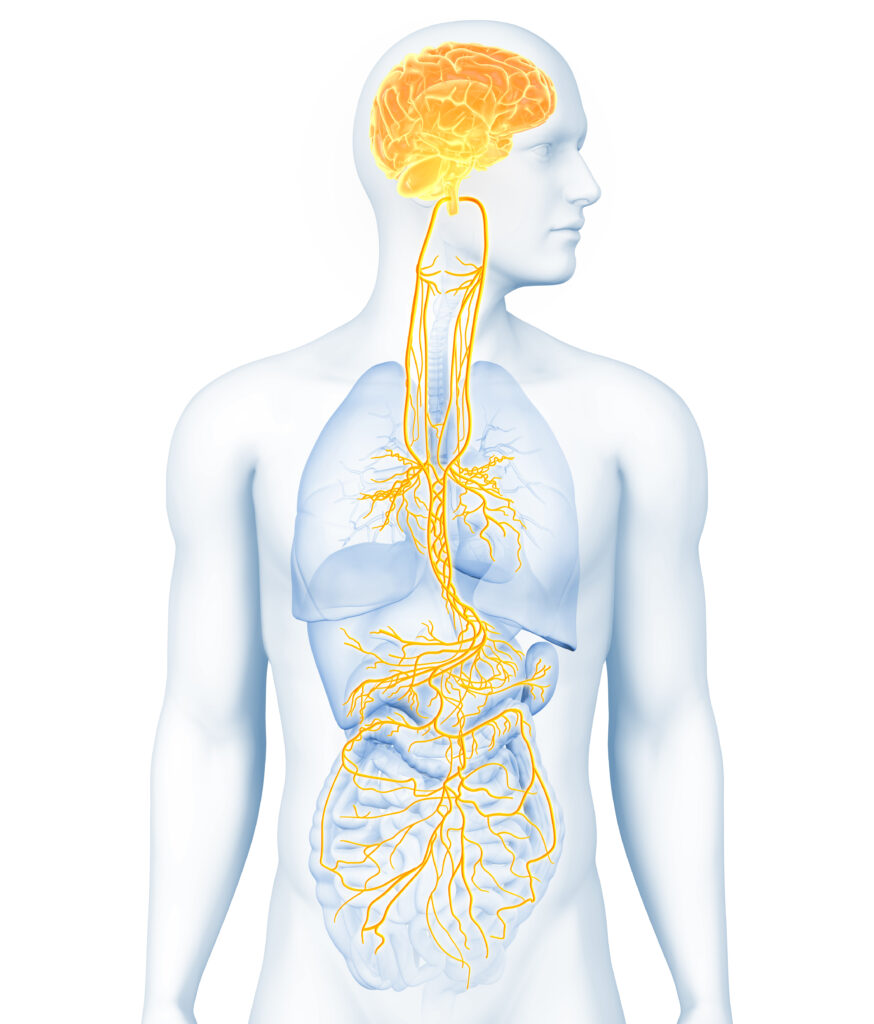Feeling stressed, rushed, hyperaroused or hypersensitive? Your autonomic nervous system is out of balance. Despite its name, your autonomic nervous system is not entirely beyond your control – you have the power to influence it. This blog reviews the autonomic nervous system and introduces you to your vagus nerve, the key nerve that induces relaxation. Next, we provide five straightforward and fun ways to activate your vagus and restore your body back into balance.
Let's get started:
- Autonomic Nervous System Essentials
- Vagus Nerve: The Key to Balance
- Five Easy Habits to Activate Your Vagus
- 1) Breathwork: Gateway to Vagus Activation
- 2) Vagus Nerve: Harmonizing Through Song
- 3) Joyful Laughter: A Vagus Nerve Activator
- 4) Mind-Body Practices: Yoga, Tai Chi, and Vagal Tone
- 5) Change your Mind
Autonomic Nervous System Essentials
The autonomic nervous system, a cornerstone of our physiological well-being, comprises two essential branches: the sympathetic and parasympathetic. The sympathetic branch, often referred to as the “Fight or Flight” system, primes the body for action in times of stress or urgency. It orchestrates a surge of energy, dilates pupils, accelerates the heart rate, and diverts blood away from non-essential functions toward muscles, preparing us to confront challenges.
In contrast, the parasympathetic system, known as the “Rest and Digest” counterpart, promotes relaxation, recovery, and sustenance. It slows the heart rate, constricts pupils, and prioritizes digestion and nutrient absorption.
In our modern, fast-paced world, many of us find ourselves entrenched in a state of sympathetic overdrive. The relentless demands of daily life, be it work pressures, constant connectivity, or various stressors, keep us in a heightened state of chronic stress.
In a perpetual chronic stress state, stress hormones like cortisol and adrenaline flood the system. While vital in the short term, this chronic exposure can lead to a spectrum of specific health concerns.

High cortisol levels weaken the immune system, hinder cognitive function, disrupt sleep, and reduce insulin sensitivity—potentially culminating in metabolic disorders such as diabetes. Elevated adrenaline levels drive up heart rate and blood pressure, exacerbating hypertension. This prolonged state can also induce chronic stress-related digestive issues like acid reflux, irritable bowel syndrome (IBS), and slowed digestion. Recognizing and addressing these effects is paramount for long-term health and well-being.
Unlocking Balance: Activating Your Vagus
So, how do you get out of sympathetic overdrive and back to a state of balance and well-being? Enter the vagus nerve, a key player in the autonomic nervous system. This remarkable nerve counterbalances the sympathetic branch, promoting relaxation, calm, and restoration. By stimulating the vagus nerve, you can effectively shift your body from ‘fight or flight’ mode into a state of ‘rest and digest,’ allowing for rejuvenation and healing.
In the following sections, we’ll explore five simple yet powerful techniques to activate and harness the potential of your vagus nerve, paving the way for a healthier, more balanced you.
Five Easy Habits to Activate Your Vagus
Exercise, meditation and nature are well-known stress relievers, and they all at least partially operate by influencing the autonomic nervous system. This section delves into less-explored techniques that offer unique pathways to activate your vagus nerve. Let’s uncover these hidden gems for a more centred and harmonious you.
1) Breathwork: Gateway to Vagus Activation

Breathing is one of the most potent keys to unlocking the potential of your vagus nerve. At the heart of this lies the pivotal role of the diaphragm—a large, dome-shaped muscle nestled at the base of our ribcage. It hosts one of the largest branches of the vagus nerve, and by deliberately engaging this muscle, we can significantly stimulate vagal activity.
To consciously engage the diaphragm, begin by relaxing your abdomen and directing your breath towards the lower part of your lungs. This action allows your lungs to extend into your abdomen, naturally causing your belly to protrude. This is why diaphragmatic breathing (breathing that activates your vagus) is also referred to as belly breathing because engaging your diaphragm automatically makes your belly push out.
Another key point in vagal activation through breath lies in the differentiation between inhalation and exhalation. Inhalation leans towards sympathetic activation, invigorating the body, while exhalation favors parasympathetic influence, coaxing relaxation.
There are several breathing exercises available, such as the 4-7-8 technique, alternate nostril breathing (a personal favourite in my morning yoga routine) and slow exhalation breathing.

The crux of choosing a method lies in two fundamental aspects: First, ensure your breath primarily fills your belly for optimal vagal activity, with minimal movement in the upper chest or collarbone area. Second, extend the duration of your exhalation (and any breath-holding) beyond that of inhalation for maximum benefit.
If you’re having difficulty breathing into your belly while seated, which is common for adults who tend to hold tension in this area and primarily breathe into their upper chest, try lying down. Position your hands, palms down, on your belly with your fingertips lightly touching. As you inhale, aim to gradually separate your fingertips with each breath to acquaint yourself with the sensation of belly breathing.
As for how long it takes to notice benefits, there’s no strict rule. However, most individuals experience a sense of relaxation after just a few rounds, typically within less than five minutes.

2) Vagus Nerve: Harmonizing Through Song
Singing and other activities involving controlled vocalizations, such as humming or chanting, hold a remarkable power to activate the vagus. When we sing, hum or chant, the controlled breath patterns and sustained exhalations engage the diaphragm, which in turn stimulates the vagus nerve. This activation fosters a state of calm and relaxation.
Scientific studies have shed light on the profound effects of singing on the vagus nerve. Research suggests that engaging in regular singing can enhance heart rate variability—a key marker of vagal tone—and reduce cortisol levels. While there’s no strict prescription for the amount or type of singing, even a few minutes of heartfelt singing each day can significantly promote vagal activation and overall wellness.
Listening to music can also stimulate the vagus nerve. Specifically, music with a slow tempo, rhythmic patterns, and soothing harmonies can promote a sense of calmness, triggering the body’s relaxation response. Additionally, music’s ability to synchronize with breathing patterns enhances vagal tone. It’s crucial to select music that personally resonates with you, as individual preferences play a significant role.

By incorporating music into relaxation practices, you can tap into its potential to foster a state of tranquillity, making it a valuable addition to your self-care routine.
3) Joyful Laughter: A Vagus Nerve Activator
One of the most impactful books I encountered during my medical studies was Norman Cousins’ personal account in “The Anatomy of an Illness.” Cousins vividly describes how laughter induced by Marx Brothers movies remarkably alleviated his pain from ankylosing spondylitis.
This seemingly anecdotal evidence is substantiated by growing research highlighting laughter’s ability to significantly reduce stress hormone levels. Just anticipating humour led to an astonishing 50% decrease in cortisol levels. Genuine smiles activate the vagus nerve’s superior laryngeal branch, sending clear signals to the brain of safety and relaxation. So, next time you’re stressed, try watching a funny TV show or reflecting on something that genuinely makes you smile.

4) Mind-Body Practices: Yoga, Tai Chi, and Vagal Tone
While aerobic exercise undeniably plays a vital role in promoting overall health and reducing stress through the release of endorphins, improved sleep, positive mood, and cortisol regulation, mind-body practices like yoga and tai chi offer a profound approach to vagus nerve activation.
Yoga stimulates the vagus nerve through a combination of specific practices that target the body’s relaxation response and enhance parasympathetic nervous system activity. Yoga strongly emphasizes conscious and controlled breathing, particularly diaphragmatic breathing. Through practices like Savasana (Corpse Pose) and Yoga Nidra, yoga encourages a state of deep relaxation. Certain yoga poses, such as child’s pose and forward fold, apply gentle pressure to specific areas of the body, like the throat and the abdomen, stimulating the vagus nerve directly . Studies have shown that regular yoga practice increases vagal tone, fostering a state of calmness and balance within the autonomic nervous system.

5) Change your Mind
In her book “7 1/2 Lessons about the Brain,” Lisa Feldman Barrett, one of the most cited scientists in the world for her revolutionary research in psychology and neuroscience, clarifies that the brain is not a reactive machine but a predictive machine. The brain’s primary function is to generate predictions about the world based on past experiences in order to navigate and interact with the environment effectively.
In other words, if you, unfortunately, experienced war, rape or any form of violence or choose to read about, watch, or think about war, rape or any form of violence, your brain becomes wired to that reality. When you are wired to that reality and hear footsteps behind you, your brain predicts danger. If you hear a loud noise, your brain predicts danger. If you are in the silent hush of nature, your brain predicts danger lurking behind every tree.
A brain wired to violence by choice or unfortunate experience predicts danger in every occasion and lives in constant ‘Fight or Flight.’ Stress hormones constantly surge through the body, elevating blood pressure, insulin resistance, insomnia, chronic stress and chronic inflammation. Your autonomic system is way out of balance.

What happens to your predictive brain if you expose it to sounds, scenes, people and animals that calm you? Your brain predicts safety. It sends signals to your heart that lower your blood pressure and heart rate. Your cortisol levels drop, and the tension you carry in your muscles subsides.
Due to the neuroplastic nature of your brain, the more your brain is exposed to calm scenes, the stronger those ” calm neural networks” will become and the weaker those “danger neural networks’ will become. By intentionally focusing on positivity, we can rewire our brains for balance and well-being.
Putting it All Together
With the realization of how powerful vagal activation is to health, technology is experimenting with vagal implants to treat conditions such as epilepsy, depression, and chronic inflammation. As we witness the field unfold, let’s explore some less drastic measures to harness the potential of the vagus nerve. Transform your life towards a calmer, healthier you. Whether through mindful breathing, the joy of laughter, the art of song, the grace of mind-body practices, or the power to change your mind, each step brings you closer to a calmer, healthier you.

Embrace the potential for positive change. By committing to these practices, you’re inviting peace and tranquillity into your life. Observe as your body and mind respond with renewed vitality. Your journey towards a calmer, healthier you begins now. Take that first step and thrive.



